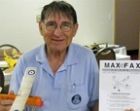About our Club
The DC Maxecuters are model aviation enthusiasts. First organized in the late 50’s, the club’s roots are in rubber-powered Free Flight, though members actively pursue other facets of the model aircraft hobby, including electric and gas-powered free-flight as well as radio control, especially micro R/C.
We fly year-round, both in select indoor venues and outdoors in the fields. Members are typically also members of other model aviation clubs, including the Academy of Model Aeronautics (AMA) , the National Free Flight Society (NFFS), the Society of Antique Modelers (SAM), and of course The Flying Aces Club (FAC)
Newsletter
The Maxecuters publish a quarterly journal, MAX-FAX. All members receive a copy. We try to produce a varied and stimulating source of free flight scale information, including plans, articles, construction and flying techniques and photos.
Dues for membership are now $25 per year for residents of the USA, Canada and
Mexico, and $35 for all other countries.
Postage rates have caused us to raise these prices as of 2013.
Send a check, payable to the
"D.C. MAXECUTERS" to the Treasurer:
Stew Meyers
8304 Whitman Dr.
Bethesda, MD 20817
To join or renew on-line go to MaxFax
Club Officers
| President: Glen Simpers |
 |
Secretary: Dave Mitchell |
 |
Treasurer & MaxFax Editor: Stew Meyers |
 |
Safety Officer: Ray Rakow |
 |
Our Planes
Free flight models fly on their own after launch. They follow the wind and soar in rising thermal currents of warm air and set their own course without any control from the ground. If you have ever tossed a folded paper airplane or a dime store balsa glider, you have flown a free flight model in its most basic form.
Free Flight models usually are trimmed to fly in circles to reduce the probability of a fly away. The model airplanes we fly are usually hand-built, primarily from balsawood and tissue paper. We sometimes use modern materials such as carbon fiber and foam, but for the most part we make these models using the same materials and methods as that a kid in the 1930s.

Somethings HAVE changed though, especially the quality of rubber that is used for motors. Free Flight modelers have increased their average flight times considerably over the “old days”. Flights of 40 to 60 seconds are fairly commonplace, with everyone angling for the coveted “max” flight of 120 seconds or better. With such long flight times and no method of controlling the model once it has been launched, many models fly OOS (out of sight), lifted by thermals into the blue horizon.